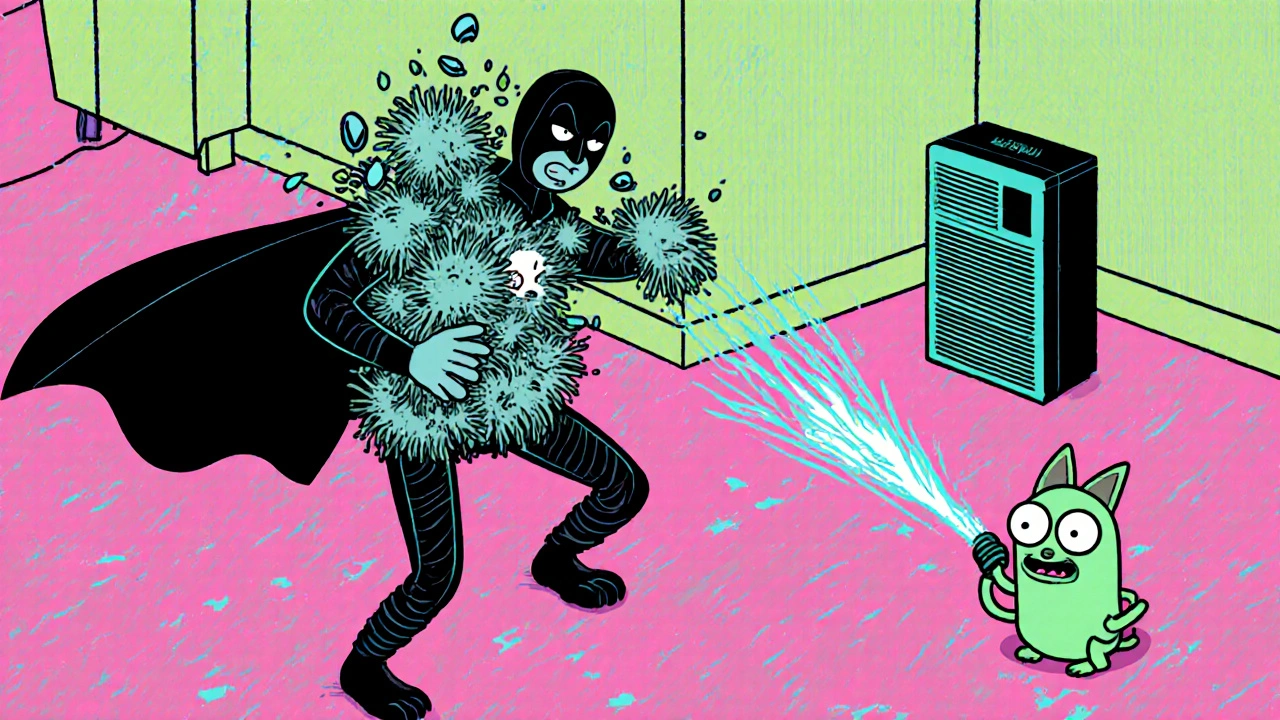 Nov, 17 2025
Nov, 17 2025
Why pet dander is the real problem - not fur
You might think your cat’s long hair or your dog’s shedding is what’s making you sneeze. But it’s not the fur. It’s the tiny flakes of skin - called dander - that stick to their fur and get shed everywhere. These particles are so small they float in the air for hours. They cling to your clothes, couches, and even your pillow. And they don’t disappear when the pet leaves the house. Studies show pet allergens can hang around in dust for up to six months.
The real culprits? Proteins. In cats, it’s Fel d 1, found in saliva and skin glands. In dogs, it’s Can f 1, mostly in saliva and skin. These proteins trigger your immune system to overreact - causing runny nose, itchy eyes, sneezing, or even asthma flare-ups. And no, there’s no such thing as a truly hypoallergenic breed. Even hairless cats and dogs produce these allergens. Some individual animals produce less, but it’s random - not tied to breed, size, or coat length.
Bedrooms must be pet-free zones
If you’re struggling with allergies, the single most effective thing you can do is keep pets out of your bedroom. It’s simple, low-cost, and backed by science. Clinical studies show that keeping pets out of the bedroom reduces nighttime allergy symptoms by up to 40%. Why? Because you spend a third of your life there. Your pillow, sheets, and blankets collect dander all day. When you sleep, you breathe it in for hours.
Don’t just ban pets from the bed - ban them from the whole room. Install a door stopper if needed. If your pet is used to sleeping with you, start slowly. Let them sleep on a blanket on the floor just outside the door for a few nights. Then move their bed to another room. Most pets adjust within a week. The payoff? Better sleep, fewer morning sneezes, and less reliance on medication.
Upgrade your vacuum - HEPA is non-negotiable
Standard vacuums? They just kick dander back into the air. Most filters can’t catch particles smaller than 1 micron. Pet dander? It’s often 0.5 microns or smaller. That’s why you need a vacuum with a true HEPA filter. HEPA stands for High-Efficiency Particulate Air. These filters trap 99.97% of particles as small as 0.3 microns - including dander, pollen, and dust mites.
Research from Filtrete shows HEPA vacuums capture 30-50% more pet dander than regular models. Look for sealed systems - meaning air doesn’t leak out around the filter. Brands like Dyson, Miele, and Shark have reliable HEPA options. You don’t need the most expensive one, but avoid budget vacuums that advertise “HEPA-like” or “HEPA-style.” Only true HEPA counts.
Vacuum at least twice a week. Focus on carpets, rugs, upholstered furniture, and pet beds. If you have hard floors, sweep first, then vacuum. Don’t forget baseboards and under furniture. It takes 15-20 minutes per session, but it’s worth it. After three months of consistent use, households report a 50-70% drop in measurable allergens.
Use air purifiers - but choose the right one
A HEPA air purifier is your second best friend after a good vacuum. It doesn’t replace vacuuming, but it cleans the air while you’re not cleaning. Look for a unit with a true HEPA filter and a CADR (Clean Air Delivery Rate) that matches your room size. For a typical bedroom or living room (200-300 sq ft), aim for a CADR of at least 200.
Studies show properly sized HEPA air purifiers can reduce airborne pet allergens by 40-60%. Place it where you spend the most time - usually the bedroom or living room. Keep it running 24/7. Turn it off only when you’re cleaning. Avoid ionizers, ozone generators, or UV-only purifiers. They don’t remove dander - they just charge particles or kill germs. Dander is physical debris. You need a filter to trap it.
Replace HEPA filters every 6-12 months. Dirty filters lose efficiency and can even re-release allergens. Budget $20-$50 per replacement. It’s cheaper than allergy meds over time.

Swap carpets for hard floors - and clean bedding weekly
Carpets are dander traps. They act like sponges, soaking up allergens and holding onto them for months. Hard flooring - hardwood, tile, linoleum - holds 50-75% less dander. If you can’t replace all your carpets, start with the bedroom and main living areas. Use washable rugs instead. Wash them weekly in hot water (at least 130°F or 54°C) to kill allergens.
Same goes for pet bedding. Wash it every week. Use the hottest water safe for the fabric. Dry on high heat. This kills dander and dust mites. If your pet sleeps on your couch or armchair, cover it with a removable, washable blanket. Wash that weekly too.
Wash your own bedding weekly. Use allergen-proof pillow and mattress covers. They’re not expensive - around $20-$40 each - and they create a barrier between you and the dander that’s already in your bed.
Bathe your pet - weekly if you can
Bathing your pet reduces allergens on their skin and fur. Water rinses away dander and saliva residue. Studies show weekly baths can reduce airborne allergens by up to 80% for a few days. The key? Use a gentle, allergen-reducing shampoo. Look for ones labeled “anti-allergen” or “dander control.” Ingredients like oatmeal, aloe, or special proteins that bind to allergens help.
But here’s the catch: 60% of cat owners say their cats hate baths. Dogs? About 35% resist. If your pet panics, don’t force it. Try wiping them down with a damp microfiber cloth daily. Or use allergen-reducing wipes (available at pet stores). They’re not as effective as a full bath, but they help. Brushing your pet outdoors with a fine-tooth comb also removes loose dander. Do it daily if possible.
Use anti-allergen sprays - but know their limits
Anti-allergen sprays can be helpful, but they’re not magic. They work by neutralizing the proteins in dander, not removing it. Independent tests show they reduce allergen potency by 30-70% on surfaces like couches, curtains, and carpets. Effects last 24-72 hours.
Use them after vacuuming. Spray lightly on fabrics, don’t soak them. Brands like Allerpet or Petal Cleanse are commonly recommended. Don’t rely on them alone. They’re a supplement, not a solution. And never spray directly on your pet. Some ingredients can irritate their skin.
Wash your hands. Use lint rollers. Don’t touch your face.
Simple habits make a huge difference. Wash your hands immediately after petting your animal. It reduces allergen transfer to your eyes and nose by 90%. Keep hand sanitizer near the door.
Use a lint roller on your clothes, couch, and car seats every day. They remove 70-85% of surface dander. Keep one by the front door and one in your car. Change your clothes after spending time with your pet, especially if you’re going to bed.
Don’t let your pet lick your face. Saliva carries the strongest allergens. If you have kids, teach them not to hug or kiss pets on the mouth.

Medication and immunotherapy - when to consider them
Environmental changes are the foundation. But if symptoms persist, medication helps. Over-the-counter antihistamines like cetirizine or loratadine work for 60-70% of people with mild allergies. They take 30-60 minutes to kick in and last 24 hours.
If symptoms are worse - especially if you have asthma - talk to an allergist. Allergy shots (immunotherapy) are the only treatment that can change how your body reacts to allergens. After 3-5 years of weekly shots, 80-85% of patients see long-term relief - even after stopping. Now, there’s also a new option: Odactra, a sublingual tablet for cat allergies. You put it under your tongue daily. It’s as effective as shots, with fewer clinic visits.
Immunotherapy isn’t cheap - it can cost $1,500-$3,000 over three years - but it’s often covered by insurance. For many, it’s the only way to keep their pet without daily symptoms.
What doesn’t work - and what to avoid
Don’t believe the hype. There’s no such thing as a hypoallergenic dog or cat. Breeds like Poodles, Bichons, or Siberians aren’t allergy-proof. They still produce Fel d 1 or Can f 1. Some individuals produce less, but you can’t tell until you live with them.
Avoid air fresheners, scented candles, or essential oils. They mask smells but don’t reduce allergens. Some even irritate lungs and worsen asthma.
Don’t delay treatment. The American College of Allergy, Asthma, and Immunology says 40% of pet owners wait 1-2 years before seeing a doctor. By then, symptoms are worse, and your body is more sensitized. Early action = better outcomes.
Realistic timeline: What to expect
Don’t expect miracles in a week. It takes 2-4 weeks to build new habits. Start with the bedroom. Then get a HEPA vacuum. Then add an air purifier. Then start weekly pet baths and bedding washes.
Most people notice improvement in 4-6 weeks. After 3 months, allergen levels drop by 50-70%. The key? Consistency. Miss a week of vacuuming? Dander builds back up fast. Skip bathing your cat for two weeks? Allergens spike again.
Initial setup costs: $200-$500. That includes a HEPA vacuum ($150-$300), air purifier ($100-$250), and a few bottles of anti-allergen shampoo. Replace filters yearly. It’s less than the cost of monthly allergy meds over two years.
What’s coming next
Science is moving fast. Researchers at UC Davis are using CRISPR gene editing to create cats that produce 90% less Fel d 1. It’s promising, but not available until at least 2028.
Smart homes are next. New air purifiers now come with sensors that detect allergen levels and auto-adjust fan speed. By 2025, these systems will be common. They’ll tell you when to clean, when to run the purifier, and even remind you to bathe your pet.
For now, the best tools are simple: clean air, clean surfaces, clean habits. You don’t need to give up your pet. You just need to be smarter about living with them.
